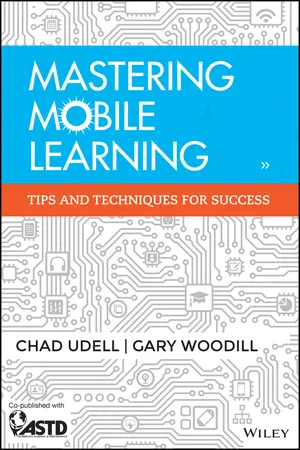
- English
- ePUB (mobile friendly)
- Available on iOS & Android
Mastering Mobile Learning
About This Book
Discover the strategies, tools, and technologies necessary for developing successful mobile learning programs
In the modern, rapidly-expanding mobile learning environment, only clear guidelines and state-of-the-art technologies will stand up to the challenges that lie ahead. With a smart focus that combines a proven process with all-important strategies and practical applications, Mastering Mobile Learning stands as the most modern, comprehensive resource on the subject. It also features unique technical content previously unavailable among the literature of the mobile learning field. This book will help you turn concept into reality.
This book will show you best practices for obtaining and providing educational, training, and professional development content on devices like smartphones, tablets and other mobile devices. Trainers, educators, designers, instructional technologists, workplace learning professionals, and HR professionals will learn how mobile learning differs from other forms of e-learning, and will be introduced to the challenges and—more importantly—the advantages of mobile learning strategies and technologies for 21 st century business environments. The book provides:
- An overview of mobile learning, including evolving definitions and reasons for executives to embrace this approach
- A discussion of the business drivers of mobile learning, advice for creating a mobile learning content strategy, and easy ways to inexpensively launch mobile learning
- Valuable tips on how to use unique affordances of mobile devices to better serve your learners while they are on the go
- Information on the ROI of mobile learning, using mobile devices as research tools, and why training in mobile development is critical
- An overview of the technical aspects of the design and development of mobile learning
Written by experts in this burgeoning field, Mastering Mobile Learning provides a roadmap for creating the most effective learning content, strategies, and applications possible.
Frequently asked questions
PART 1
UNDERSTANDING MOBILE LEARNING
Chapter 1
Enterprise Mobile Learning
A Primer

Business Drivers of Mobile Learning
- The need for speedier training is evident. Because we live in a time of rapid technological change, there is often a need for more frequent training as new procedures, strategies, and technologies are adopted by companies.
- Time available for training has been reduced. At the same time, hyper-competition and the demand for multitasking by workers has meant that there is less time available for training. Training often has to be done “on-the-fly” or outside work environments. Mobile learning offers one solution to this problem.
- Mobile learning reinforces a major goal of enterprise learning and development departments. Enterprise learning is a bit of a misnomer. In reality, most enterprise training is actually meant to increase performance and has very little to do with what is traditionally thought of as acquiring new knowledge. Gaining knowledge and long-term retention of information is often a side-effect of corporate training; but make no mistake, if companies could forego training employees and still maintain or increase performance, they would. Mobile allows resources in the learning and development departments to be spent on efforts to increase performance by having information available when needed, rather retaining knowledge for a long time.
- The infrastructure for mobile learning is already in place. The widespread deployment of mobile computing means that the infrastructure for mobile learning is usually in place, and most workers already carry a mobile device with them most of the time. While some companies want to issue standard, “company liable” smart phones or tablets to their employees, many organizations are taking advantage of the existing situation by using a “bring your own device” (BYOD) strategy.
- Many workers are already mobile. For many jobs, the workforce is already “on the road,” meaning that it is often expensive to bring them into a central location for training. Still other workers don’t go into the workplace every day, but work from home or from other locations. Some are commuters who may be able to work while using public transportation to reach their physical workplaces. Finally, within a large building or campus, employees may move around a specific area as part of their jobs. All this means that, for many workers, mobile learning already fits with their lifestyle and work habits.
- With globalization, mobile devices may be the best way to reach all employees. Global sourcing and global labor mean that employees or customers who need training may be anywhere in the world. For some, a mobile smart phone or tablet may be the only computing device available.
The Mobile Learning Ecosystem
Mobile Learning Applications
Content Transmission and Retrieval
Capturing Data
Communicating and Interacting with Others
Computing Algorithms
Contextual Inquiry
Designing and Creating Mobile Learning Content
Table of contents
- Cover
- Contents
- Title
- Copyright
- Foreword
- Preface
- Introduction
- Part 1: Understanding Mobile Learning
- Part 2: Strategic Thinking About Mobile Learning
- Part 3: The Varieties of Mobile Learning Experiences
- Part 4: Design and Development Processes for Mobile Learning
- Part 5: Managing and Delivering Mobile Learning Projects
- About the Authors
- About the Contributors
- About the Association for Talent Development
- Index
- End User License Agreement